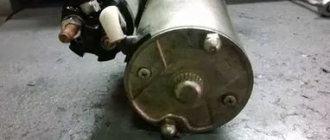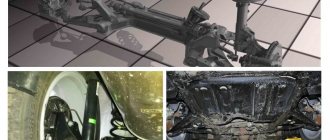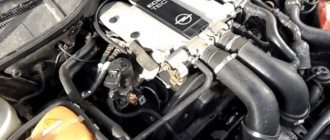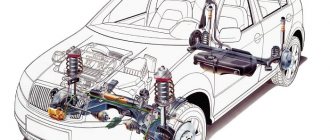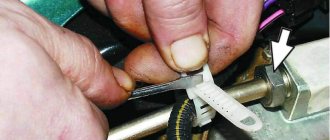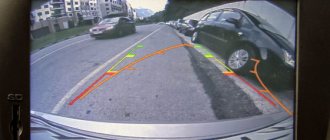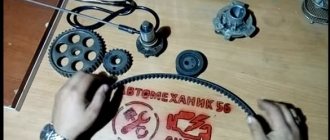If any problems occur, which usually affect not one system, but several at once, for these reasons the Lada Vesta does not start in the cold in winter, or when there are many of these problems. The engine can stall for many reasons. Of course, it is better that problems do not occur, or are at the beginning of the path, and not in the middle, in the middle of an open field. But, despite the optimism, this problem is quite serious; checking the fuses alone is unlikely to get by. Everyone is subject to this - both vesta amt and Lada Vesta with a manual transmission. The reason why the Lada Vesta does not start well often lies in the starting systems, engine power supply, and fuel system. The starter does not turn, or, on the contrary, it turns but the car does not start. Also, sometimes the engine stalls due to a torn timing belt, or poor sensor performance. Perhaps your Lada Vesta is stalling due to the cold! Next we will look at several of the most common situations and various reasons for each of them. Some of the work described here is difficult to do yourself - if you are not a mechanic, but at least you will know what can be broken!
Life hack: Lada Vesta won’t start - reasons
If any problems occur, which usually affect not one system, but several at once, for these reasons the Lada Vesta does not start in the cold in winter, or when there are many of these problems. The engine can stall for many reasons. Of course, it is better that problems do not occur, or are at the beginning of the path, and not in the middle, in the middle of an open field. But, despite the optimism, this problem is quite serious; checking the fuses alone is unlikely to get by. Everyone is subject to this - both vesta amt and Lada Vesta with a manual transmission. The reason why the Lada Vesta does not start well often lies in the starting systems, engine power supply, and fuel system. The starter does not turn, or, on the contrary, it turns but the car does not start. Also, sometimes the engine stalls due to a torn timing belt, or poor sensor performance. Perhaps your Lada Vesta is stalling due to the cold! Next we will look at several of the most common situations and various reasons for each of them. Some of the work described here is difficult to do yourself - if you are not a mechanic, but at least you will know what can be broken!
Chassis:
A very common problem is weak stabilizer links . The problem was noticed on the first Lada Vesta. Literally after 3 thousand kilometers they begin to tap.
There is also the creaking of stabilizer rubber bands on smooth metal when moving over bumps. The creaking is eliminated under warranty by sanding the smooth surface of the metal with sandpaper.
AvtoVAZ argues this problem is a bad supplier, which has already been replaced by a supplier of better quality racks.
At a mileage of 30 thousand km, play may appear in the lower bearings of the steering knuckle . Subsequently, AvtoVAZ eliminated the play of the ball joint by changing the liner housing, which also simultaneously solved the problem of squeaks when turning the wheels.
Factory alloy wheels are so weak that they bend when the wheel gets into even a small hole, which is why you can often hear them called “paper”.
Transmission:
Errors in the automatic transmission algorithm , the automatic transmission can be thoughtful at times, and “nodding” occurs when changing gears. The reason for this is a glitch in the first firmware. It can be solved by reflashing it from an official dealer. As for the manual transmission, the situation is better; only on some of the first Vestas with manual transmission do difficulties appear in shifting gears .
After 15,000 km, on some manual gearboxes from Renault (JH3), the bearing began to howl, and 1st, 2nd and 3rd gears were difficult to engage (the rod blocking block stuck in its hole).
Salon:
Cricket behind the instrument panel . It can be eliminated quite easily by removing the panel and installing sealing materials under the creaking plastic.
The paint on the steering wheel lining wears off quickly . Moreover, even after a warranty replacement, abrasions quickly appear.
At 4th or 5th speed of the heater fan, vibration appears on the steering wheel . This is due to contamination of the impeller. By the way, in the cars of 2022, this problem was not solved in Vesta.
The trim on the rear doors is coming off .
There is a knocking sound from the cables under the side door trim. It can also be easily removed by fixing them. All these problems concern the first releases of Vesta; most likely, they will be corrected in the future, because as practice shows, AvtoVAZ reacts quite quickly to emerging childhood problems.
Electronics:
Multimedia glitches , there are many complaints that when AUX mode is running on the multimedia system, a black screen appears when the rear view camera is turned on. Or the multimedia does not start at all unless you do a hard reset. Most likely this is also a temporary problem with the first machines, which will be eliminated with new firmware.
There are also cases of the heated windshield not working. Possible reasons: either the firmware or the fuse (there are two of them).
The ignition coil was noticed to fail (on cars from the first batch), it was replaced under warranty.
Door limit switches begin to fail at 20 thousand mileage.
Body:
When driving around 3 thousand km, when using standard frame wipers, scratches appear on the windshield . Here it’s like on old VAZs - “buy a new car and immediately change the wipers.” The case is under warranty and the official dealer will replace the glass.
The front and rear bumpers suffer greatly from chips and scratches, and the paint on it begins to peel off along with the varnish.
Another common drawback of Vesta is that the velvet covers fit too tightly to the side windows. If sand gets in and you still use the power windows, scratches will form on the side windows , the appearance of which is accompanied by a squeaking sound. The official instructions from AvtoVAZ in this case are to cut off two sides of the seal.
There have been cases of dirt accumulating under the hood due to the absence of a section of the hood seal in the lock area . Dirt not only spoils the appearance, but is also harmful to engine compartment devices, such as the generator, belts, electricians, and the like. This problem is relevant for the Lada Vesta of the first releases. Can be cured by installing another seal.
And after six months of operation, the door hinges may begin to creak, naturally, after lubrication everything goes away, but the very fact that the factory lubrication is not enough for a long time is a little upsetting.
Headlights:
The headlights themselves are fine, but for some reason the turn signals on the side rearview mirrors
Exhaust system:
After 30 thousand km, the rubber bands securing the muffler begin to sag and these “carrots” simply break.
Breaking off of brackets on the exhaust exhaust pipe - steel nuts were used instead of brass.
What changes have been made to Vesta cars produced in 2016 and 2022?
These are, in principle, all the problems that a car can suffer from.
Yes, it is damp and expensive when compared with Korean counterparts like Solaris or Rio, but they also had many shortcomings in their time, which, by the way, the manufacturer was in no hurry to eliminate.
But no one could imagine that a new VAZ car would have only a couple of “childhood diseases”, each of which can be easily and inexpensively eliminated.
Summary
To summarize, we can say that despite the minor shortcomings of the Lada Vesta, the car as a whole turned out great. There is good handling, excellent design, good ergonomics and a good landing, in which severe fatigue is not noticed even on long trips.
Most likely, the identified problems with the Lada Vesta will be eliminated in the future. After all, each car produced has a personal manager attached to it. If you contact him, a technical inspection will be promptly organized by an official dealer.
Each detected case of Vesta malfunction is documented, then data on the breakdown is sent to the manufacturer for elimination in subsequent production. The car is new in every sense of the word, so the article will be updated as new problems arise.
You can help us make this article better. Leave any Lada Vesta problems you notice in x.
Did not find an answer to your question?
Ask in x. We will definitely answer!
for repair of VAZ (Lada) Vesta
Source: https://etlib.ru/blog/450-slabye-mesta-lada-vesta
Lada Vesta starts and immediately stalls - reasons
- Make sure you have filled the tank. Everything is much simpler than you think;
- The alarm blocked the car engine from starting;
- If you are near a service station: try checking the crankshaft and throttle sensors;
- There may be a problem with the ignition system. Review the ignition coil, the correct sequence in connecting the wires;
- If, when you release the gas pedal, the car immediately stalls, then most likely the problem is in the idle air control regulator and its circuit;
- Check the catalytic manifold/receiver exhaust pipe, the problem may be their depressurization;
- Perhaps the air flow sensor indicator requires attention;
- Abnormal pressure in the fuel system of the Lada Vesta must be excluded;
- We need to diagnose the operation of the engine control system.
Problem: Vesta does not start the first time or seizes and stalls
If the reason that the car does not start well, or does not grab well the first time, has not been identified, move on:
- The cause may be bad gasoline. Try experimenting with this;
- Due to a discharged battery, the crankshaft rotates too slowly;
- The engine oil may have thickened due to frost;
- Battery terminals: oxidized or loosely screwed;
- Check the condition of the fuel injectors. Usually the problem lies in the fuel system;
- The timing belt may be broken, or simply jumped on the teeth. Look at its condition and the match of marks;
- DPKV and its circuit are a possible cause of the problem;
- Check the coolant;
- Make sure: the fuses and relays are in good condition;
- Check all contacts of electrical control and power circuits for reliability;
- Weak cylinder compression;
- Review all clamps, bayonets, and hose fittings. The issue may be in the intake tract and air leaks.
Find out why the Lada Vesta does not start in cold weather
A serviceable car starts up calmly up to 30-35 degrees, but with a lower temperature it is already in question, but it’s still worth a try - warming up in advance is good.
- The battery is discharged, replace or charge it;
- The Lada Vesta will not start in the cold if there is water in the tank or lines. It needs to be eliminated, replace gasoline with something more suitable for your climate;
- Examine the engine temperature sensor (coolant temperature sensor), control system;
- If you release the accelerator lever and the car stalls, then the problem is in the idle speed sensor;
- Establish the serviceability of the contactless ignition coil;
- The oxygen regulator should not be ruled out either;
- The electrical network of the ignition system modules is faulty;
- Review and, if necessary, diagnose the engine control system.
How to start a car in winter?
Moments of a successful winter launch are a separate topic. If the car does not start, you should resort to the following actions. First, turn on the ignition, and then activate the low beam headlights. We wait about 30 seconds and turn off the optical devices. This warms up the battery. But if the car starts and stalls, the reason may be precisely the temperature difference.
We engage neutral gear (if manual transmission) and depress the clutch pedal. Turn the key and listen to the starter. If the launch is unsuccessful, then repeat the procedure again.
Failure again? The battery is probably frozen. The solution is to take the battery to a warm room and recharge it or “light it” from another car.
The engine does not start, the starter does not turn - what to do?
- The battery may be low or simply faulty. The problem may also be poor terminal contact. Pay attention to the emergency lights, its frequent signals indicate poor contact of the wires;
- The Vesta starter does not turn if there are problems with the ignition switch or with attachments;
- The starter wiring also tends to fail;
- Completely check all parts of the automatic winding drive;
- Tighten the ignition system module nuts. If it spins, then the traction relay is broken and should be replaced;
- The whole point may also be a breakdown of the starter traction relay, electrical circuit, or some parts of the Lada Vesta drive;
- The problem may be specifically in the starter motor. View all windings, armature, brush assembly;
- Check the rotation of the crankshaft, pump, and Lada Vesta generator pulley - they may jam;
- Perhaps the ignition switch needs to be addressed;
Battery grants
Determining whether the battery has enough charge is quite simple. Do this:
- turn on the tester;
- unscrew the negative terminal from the battery;
- measure the voltage by applying one probe to it, and the second to “plus”.
Ideally you will get at least 9 volts. If the indicator turns out to be lower, then there are two options:
- the battery is being charged;
- The car starts by “lighting up”, and the battery restores its power while on the road, receiving energy from the generator.
When working on a Lada battery, be sure to inspect its terminals and the wires connected to them. It is better to completely remove the latter, clean them and check the integrity of the insulation.
Lada Vesta won't start
Lada Vesta, like many other representatives of the Russian automobile industry, has a number of shortcomings.
Despite the fact that the car of this brand was released quite recently, its owners had questions about the problem of starting the car, especially in cold weather.
The engine is started by supplying an air-fuel mixture to the cylinders, which ignites under the influence of an incendiary spark.
When a car does not start, this indicates that the ignition process is disrupted due to problems in the engine itself or in the ignition circuit.
Call Lada Assistance again
There is still almost a year left until the end of the warranty, so it was logical to contact the AvtoVAZ roadside assistance service. Last time they simply solved the problem on the spot by lighting our vest, but this time they tossed us in a tow truck to the nearest dealer.
The dealer's receptionist asked me to start the car and at the same time checked the oil level (there was about half of the dipstick there). After these manipulations, it turned out that the warranty specialist would be able to accept the car only after five days. It's a long time coming, but it's a pandemic. It's nothing you can do.
The tow truck, like last time, is not branded
Causes of problems
It is worth considering several options for reasons why the Lada Vesta may not start:
- The starter does not work or does not work correctly.
- Poor fuel mixture.
- Violation of the structure and function of the timing belt.
- Malfunction of electrical sensors (idle speed or temperature).
- Malfunctions in the ignition system (plugs, ignition coils and circuits).
- State of relays and fuses.
- Quite a bad contact in the electrical circuit of the engine power supply and the operation of the control system.
- Inadequate operation of the immobilizer.
- Problems with the battery - it is completely discharged or there are problems with the contacts.
- Malfunction in the alarm system - blockage in the control system.
Based on the above problems, in the winter season the first five reasons are quite common, due to which the car begins to “triple” or stall.
Starter problems and solutions
The starter may not work correctly or may not work at all due to a discharged battery - there is no supply of electrical impulses, then the starter will not crank.
If there is a problem with the battery, you should replace it with a new one. Before installation, make sure whether the battery is working or not. If the owner of a Lada Vesta is confident that the battery is working properly, charge it and check it. If the indicators are negative, replace the battery.
The second reason for poor starter cranking is unreliable contacts in the electrical circuit. If the terminals are dirty, clean and recheck. It is also necessary to check the integrity of the starter wiring. If there are defects, replace them.
It is possible that there is a problem with the starter itself. If it is faulty, the best option in this situation is to replace it with a proven new starter. If there is not enough money to purchase a new starter, repair it.
Problems in its operation can be: poor relay traction, weak fastening, malfunctions in the structure of the armature, windings, brush units. If the problem is in the fastening itself, tighten the nuts with a screwdriver. If the starter continues to spin, replace the traction relay.
Why did the engine stop?
One of the possible reasons why the engine stalls on the road is a clogged throttle valve. The problem is solved by cleaning it. Contamination of the fuel filter with low-quality fuel can also cause the engine to stop while driving. Sometimes this only appears a long time after refueling. There is only one solution: drain the bad gasoline and change the filter.
Has the engine stalled while driving and won't start? Most likely, the generator has broken down or its drive belt has broken. When this happens, the on-board network does not receive the necessary power, the battery runs out and the starter can no longer turn.
The Lada Granta may not start due to the fact that one of the on-board electrical devices, for example, a radio, was left on while parked. Keep an eye on this when parking your car for a long time.
Lada Vesta Russian Greyhound › Logbook › It doesn’t start well on the Hot one - WON!
Sorry that there are practically no photos, since I did it without even thinking about positive results.
So in the previous post I described the general symptoms of the problem. Namely: 1- After turning off the engine and trying to start it after at least 5 minutes, the car started and stalled. This cycle could be repeated up to 3-4 times. 2-When starting the engine, the idle speed dropped to 500-600 rpm. and after 30-60 seconds the car stalled.
In these cases, it helped to start the car with the gas pedal depressed.
Until today, I changed the DTOZH, but it had no effect. The spark plugs were also changed - 0 results!
Today I decided to check the pressure in the fuel rail. I arrived at the garage and connected the pressure gauge. While I was cranking it up, I drained the fuel from the ramp. I started the car, let it run for half a minute and turned it off. Rail pressure 3.6-3.8. I didn’t look at it exactly; it’s a no brainer that the pressure is normal.
After 3 minutes I started starting the car: The first time the car couldn’t handle idling. On the second start, the idle dropped to 600rpm. At this moment there was pressure on the pressure gauge as I indicated earlier. CONCLUSION: It's not about pressure.
Then I decided to remove the throttle. ATTENTION! When removing the throttle, unscrew the lower flange stud, be careful. The M8 nut may fall out.
When removing the throttle, what I discovered: Everything was clean on the air filter side. But on the side of the intake manifold there was a little dirt (soot, I don’t know what to call it). Unfortunately, I didn’t take a photo, but there’s literally not much of it. Upon further inspection of the throttle and valve, I discovered that the valve was almost closed in its normal state, and visually at first I thought that it was indeed completely closed. Since when flushing the throttle on other cars with e-gas, the valve gap was always visible even in a dirty state, but here at first it’s not visible.
Although the throttle was a little dirty, I decided to wash it. Naturally, I washed it with carburetor cleaner and washed it with a clean rag. In general, I brought the damper inside to a clean state - “off the assembly line”.
Not particularly believing in success, I decided to climb into the damper mechanism hidden behind a plastic casing.
The casing is secured with 4 torx bolts, most likely T20. I didn't find anything technological inside. When disassembling, when you completely unscrew all the bolts, it is better to place the throttle on a workbench (table) with the casing up. Inside you will find: a motor, a removable gear, and a crescent-shaped gear, which is attached to the damper through a rod. Only the removable gear is removed, everything else stays in place. The gears were dry, but it was clear that there was some grease inside. The removable gear, the gear on the electric motor, and the crescent gear were lubricated with bearing grease (blue), because I didn’t find lithol in the garage. And having assembled the throttle back into place, I installed it in its rightful place.
Eventually! Today I drove around the city all day, with frequent stops, and the car started without problems. Neither falling revolutions nor lack of idle appeared today. And the jerking when driving in 1st or 2nd gear at idle also disappeared.
I DID NOT DO ANY ADAPTATION AFTER REMOVING THE FLAP.
GENERAL CONCLUSION: 1) Wash the throttle thoroughly, even if yours is slightly dirty. As it turned out, the hole when the damper is completely closed is very small, and a small “spray” of dirt leads to an unstable start of the engine when hot.
2) Disassemble the throttle and lubricate the gears. Elementarily understandable. I'm not sure if this will help, but it won't make it worse.
From observations: 1) the throttle has a small hole inside of which there is a torx screw.
Lada Vesta: eternal damnation or temporary difficulties?
Lifehacks
The main complaints from consumers concern the domestic 1.6-liter engine with 106 horsepower. The most common problems: the engine “troubles”, and at idle the speed “floats”. All this is accompanied by irritating vibrations, a decrease in unit power (one cylinder does not work) and an increase in fuel consumption. Dealers consider this problem individually, since it depends on many factors, including the most common one - fuel quality. For example, our test car (with a 106-horsepower engine and five-speed manual transmission) did not have such a problem. But the second “sore” showed itself: the engine does not start immediately, but after several seconds of starter operation. Simply put, not with half a turn, as any engine should start.
Plus, after they began installing the Russian VAZ-21807 gearbox on the Vesta (previously it had a Renault transmission), complaints arose about unclear gear shifting and whining. AvtoVAZ corrected the gear shift mechanism itself, but the annoying transmission noise remained.
The engine does not start, the starter does not turn
- The battery is discharged. Charge, replace with a new one, or install a known working one for testing.
- Poor contact at battery terminals. Clean oxidized terminals and tighten if necessary.
- Malfunction in the starter electrical circuit. Check starter wiring.
- Starter drive parts are faulty. Check the starter (temporarily install a known working starter) and repair if necessary.
- The starter traction relay is faulty. Close the starter nuts with a screwdriver; if the starter spins, the traction relay should be replaced with a new one.
- The starter motor (armature, windings, brush assembly) is faulty. Check the starter (temporarily install a known working starter) and repair if necessary.
- The ignition switch is faulty. Check and repair if necessary.
- The engine or attachments are jammed. Check the rotation of the crankshaft, pump and generator pulley. Make repairs if necessary.
Flooded candles are to blame
Experienced colleagues explained that this happens periodically in cold weather with autostart. Sometimes, for some reason, it cannot start the first time and begins to repeat the starting process again. But at the same time, the starter does not spin long enough for the engine to start, and fuel is already supplied to it. That's why the candles are flooded. A quick Google confirmed this theory. Similar messages and many theories about the origin of this problem were found on forums of different brands.
The starter turns, does not start well or does not engage
- There is no gasoline in the fuel tank.
- The battery is discharged, the crankshaft rotates too slowly. Charge or replace the battery.
- Increased crankshaft rotation resistance. In cold weather, engine oil froze.
- Battery terminals are oxidized or not tightened sufficiently. Strip and tighten.
- The problem is in the car's fuel system. There is no required fuel pressure, tightness, or the injectors are faulty. Check the fuel pump, fuel pressure regulator, fuel line and injector operation.
- The timing belt (gas distribution mechanism) is broken. Replace the belt.
- The timing belt has slipped several teeth. Check that the marks match. Tension and install the belt correctly.
- Ignition system malfunctions. The electrical circuit of the ignition coils, high-voltage wires, and spark plugs are faulty. Check the wiring, spark plugs, the order of connecting high-voltage wires and, if necessary, replace faulty parts.
- The crankshaft position sensor (CPS) or its circuit is faulty. Check and replace.
- The coolant temperature sensor (DTOZH) is faulty. Check and replace.
- The idle air control (IAC) or its circuits are faulty. If the engine starts with the gas pedal pressed and stalls when the gas pedal is released, then the sensor is faulty.
- The fuse is blown or the main relay of the control system is faulty. Check fuses and relays.
- Unreliable connection of electrical circuits of engine control and power supply systems. Check all ground attachment points, connector connections, and reliability of contacts in the blocks.
- Insufficient compression in the cylinders.
- The engine control system is faulty. Run diagnostics.
- The immobilizer blocks the engine from starting.
- Air leak into the intake tract. Inspect the joints and fittings of the hoses and clamps.
Poor starting when cold or no starting at all
- The battery is discharged, the crankshaft does not rotate fast enough. Charge or replace the battery.
- The reason is in the car's fuel system. There is water in the tank or lines. Remove water. Either the gasoline is bad or of poor quality, change the gas station.
- The coolant temperature sensor (DTOZH) of the engine management system is faulty.
- The idle air control (IAC) or its circuits are faulty. If the engine starts with the gas pedal pressed and stalls when the gas pedal is released, then the sensor is faulty.
- The ignition module is faulty. Check, replace with a new one.
- The oxygen sensor (lambda probe) is faulty.
- Fuel injectors are leaking. Check and replace if necessary.
- The engine control system is faulty. Run diagnostics.
- Check all 17 points above.
Starting a car in winter
Winter launch is a separate issue. First you just need to turn on the ignition. At the same time, the low beam will automatically turn on; you need to keep it on for at least 20 seconds, then turn it off so that the starting charge accumulates. Do not turn on any more appliances.
Place the gear in neutral and depress the clutch. Turn the key and listen to the starter. After a few revolutions the engine should start. If this does not happen, it means that the starting charge has not reached the target and needs to be accumulated again.
If it doesn’t work on the second try, it means the battery is frozen. There are two options left: start it from another car (the so-called lighting), or take the battery home for heating. As a last resort, there is still an attempt to start in tow, engaging second gear.
This method does not work on a Grant with an automatic transmission.
Doesn't start well when hot or doesn't grab at all
- The air filter is clogged. Replace.
- The coolant temperature sensor (DTOZH) of the engine management system is faulty.
- The mass air flow sensor (MAF) is faulty. Check or install a known working one.
- The problem is in the car's fuel system. There is no required fuel pressure, tightness, or the injectors are faulty. Check the fuel pump, fuel pressure regulator, fuel line and injector operation.
- The ignition module is faulty. Check, replace with a new one.
- The engine control system is faulty. Run diagnostics.
- Check all 16 points above.
Starts and stalls, does not start the first time
- The start is blocked by the alarm/immobilizer.
- The throttle position sensor (TPS) is faulty.
- The mass air flow sensor (MAF) is faulty. Check or install a known working one.
- The idle air control (IAC) or its circuits are faulty. If the engine starts with the gas pedal pressed and stalls when the gas pedal is released, then the sensor is faulty.
- Ignition system malfunctions. The electrical circuit of the ignition coils, high-voltage wires, and spark plugs are faulty. Check the wiring, spark plugs, the order of connecting high-voltage wires and, if necessary, replace faulty parts.
- Insufficient pressure in the vehicle's fuel system.
- The connections of the intake tract parts are leaking (catalytic manifold or intake manifold receiver).
- The engine control system is faulty. Run diagnostics.
- Check all 16 points above.
In the comments, we solve the issues of operating cars with VAZ 21129, 21179 and Renault-Nissan HR16DE/H4M engines installed on Vesta and XRAY, which are associated with poor starting, or when the engine cannot be started at all. We also compile statistics (participate in the survey) and identify weak points in the car. Problems with Vesta/XRAY on other topics are discussed on the forum, where you can create your own question.
Categories of products that may be of interest to you based on the article “Why Lada Vesta/XRAY does not start, causes of malfunctions”:
Check the fuses in the engine compartment
Make sure the fuses in the engine compartment mounting block are working properly. For example, on a Lada Vesta, fuse F69 (15A) is responsible not only for the air conditioning clutch, but also for powering the ignition coils and injectors (the instruction manual does not say this, writes geldor).
In the comments, we solve the issues of operating cars with VAZ 21129, 21179 and Renault-Nissan HR16DE/H4M engines installed on Vesta and XRAY, which are associated with poor starting, or when the engine cannot be started at all. We also compile statistics (participate in the survey) and identify weak points in the car. Problems with Vesta/XRAY on other topics are discussed on the forum, where you can create your own question.
